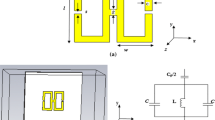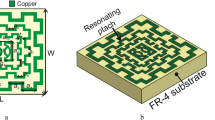Abstract
This paper explores a novel metamaterial-inspired low-scattering electric quadrupole antenna in the microwave regime. The metasurface unit cell used here is the well-known stacked dogbone doublet which is conventionally used to get electric and magnetic resonances under plane wave illumination. An offset in the position of the upper dogbone metallization results in the excitation of the higher-order high-Q electric quadrupole resonance having insignificant scattering in comparison with the fundamental resonances. This unit cell is hence used as the base element of an antenna and electric quadrupole resonance is excited using direct probe feed while the fundamental electric and magnetic resonances are suppressed. The fabricated antenna shows a 2:1 VSWR bandwidth of 4% and a measured radiation efficiency of 42% around resonance. The experimental studies are conducted inside an anechoic chamber using a vector network analyzer, computational studies are performed using the full-wave CST Microwave Studio and these results are validated using the multipole scattering theory.












Similar content being viewed by others
Data Availability
Data will be available from the authors upon reasonable request.
References
Bohren, C. F., & Huffman, D. R. (1983). Absorption and scattering of light by small particles. Wiley.
Kerker, M., Wang, D. S., & Giles, L. (1983). Electromagnetic scattering by magnetic spheres. Journal of the Optical Society of America, 73, 765–767. https://doi.org/10.1364/JOSA.73.000765
Zhu, B. O., Zhao, J., & Feng, Y. (2013). Active impedance metasurface with full 3600 reflection phase tuning. Nature Scientific Reports, 49, 1–6. https://doi.org/10.1038/srep03059
Zhu, B. O., Chen, K., Jia, N., Sun, L., Zhao, J., Jiang, T., & Feng, Y. (2014). Dynamic control of electromagnetic wave propagation with the equivalent principle inspired tunable metasurface. Nature Scientific Reports, 4, 1–7. https://doi.org/10.1038/srep04971
Shelby, R. A., Smith, D. R., & Shultz, S. (2001). Experimental verification of a negative index of refraction. Science, 292(5514), 77–79. https://doi.org/10.1126/science.1058847
Eleftheriades, G. V., Iyer, A. K., & Kremer, P. C. (2002). Planar negative refractive index media using periodically L-C loaded transmission lines. IEEE Transactions on Microwave Theory and Techniques, 50(12), 2702. https://doi.org/10.1109/TMTT.2002.805197
Shan, D., Wang, H., Cao, K., et al. (2022). Wireless power transfer system with enhanced efficiency by using frequency reconfigurable metamaterial. Scientific Reports, 12, 331. https://doi.org/10.1038/s41598-021-03570-8
Fano, U. (1961). Effects of configuration interaction on intensities and phase shifts. Physical Review. American Physical Society (APS), 124(6), 1866–1878. https://doi.org/10.1103/physrev.124.1866
Luk’yanchuk, B., Zheludev, N. I., Maier, S. A., Halas, N. J., Nordlander, P., Giessen, H., & Chong, C. T. (2010). The Fano resonance in plasmonic nanostructures and metamaterials. Nature Materials, 9(9), 707–715. https://doi.org/10.1038/nmat2810
Wang, Z. B., Luk’yanchuk, B. S., Yue, L., Yan, B., Monks, J., Dhama, R., Minin, O. V., Minin, I. V., Huang, S., & Fedyanin, A. (2019). High order Fano resonances and giant magnetic fields in dielectric microspheres. Scientific Reports Springer Nature Limited., 9(1), 20293. https://doi.org/10.1038/s41598-019-56783-3
Shafiei, F., Monticone, F., Le, K., et al. (2013). A subwavelength plasmonic metamolecule exhibiting magnetic-based optical Fano resonance. Nature Nanotech, 8, 95–99. https://doi.org/10.1038/nnano.2012.249
Rybin, M. V., Kapitanova, P. V., Filonov, D. S., Slobozhanyuk, A. P., Belov, P. A., Kivshar, Y. S., & Limonov, M. F. (2013). Fano resonances in antennas: General control over radiation patterns. Physical Review B, 88, 205106. https://doi.org/10.1103/PhysRevB.88.205106
Alù, A., & Maslovski, S. (2010). Power relations and a consistent analytical model for receiving wire antennas. IEEE Transactions on Antennas and Propagation, 58(5), 1436–1448. https://doi.org/10.1109/TAP.2010.2044354
Bach Andersen, J., & Frandsen, A. (2005). Absorption efficiency of receiving antennas. IEEE Transactions on Antennas and Propagation, 53, 2843–2849. https://doi.org/10.1109/TAP.2005.854532
Kwon, D. H., & Pozar, D. M. (2009). Optimal characteristics of an arbitrary receive antenna. IEEE Trans. Antenn. Propag., 57, 3720–3727. https://doi.org/10.1109/TAP.2009.2025975
Andrea Alù and Nader Engheta, “Cloaking a Sensor”, Phys. Rev. Lett. 2009, 102, 233901. https://doi.org/10.1103/PhysRevLett.102.233901
Alù, A., & Engheta, N. (2010). Cloaking a receiving antenna or a sensor with plasmonic metamaterials. Metamaterials, 4, 153–159. https://doi.org/10.1016/j.metmat.2010.03.005
B Urul, H Dogan, IB Basyigit, A Genc (2022) A novel broadband double-ring holed element metasurface absorber to suppress EMI from PCB heatsinks. Turkish Journal of Electrical Engineering and Computer Sciences; 30: 2254–2267. https://doi.org/10.55730/1300-0632.3937
Basyigit, I. B., Genc, A., & HelHel, S. (2019). Effect of orientation of RF sources maintained within the enclosures on electrical shielding effectiveness performance. Turkish Journal of Electrical Engineering & Computer Sciences., 27(4), 3088–3097. https://doi.org/10.3906/elk-1902-68
Baccarelli, P., Capolino, F., Paulotto, S., & Yakovlev, A. B. (2011). “In-plane modal analysis of a metalayer formed by arrayed pairs of dogbone-shaped conductors. Metamaterials, 5(1), 26–35. https://doi.org/10.1016/j.metmat.2011.02.002
Sarin, V. P., Pradeep, A., Jayakrishnan, M. P., Chandroth, A., Mohanan, P., & Vasudevan, K. (2016). Tailoring the spectral response of a dogbone doublet metamaterial. Microwave and Optical Technology Letters, 58(6), 1347–1353.
Pushpakaran, S. V., SeidMuhammed, N. M., Raj, R. K., Pradeep, A., Mohanan, P., & Vasudevan, K. (2013). A compact stacked dipole antenna with directional radiation coverage for wireless communications. IEEE Antennas and Wireless Propagation Letters, 12, 841–844. https://doi.org/10.1109/LAWP.2013.2270951
Pushpakaran, S. V., Raj, R. K., Vinesh, P. V., Dinesh, R., Mohanan, P., & Vasudevan, K. (2014). A metaresonator inspired dual band antenna for wireless applications. IEEE Transactions on Antennas and Propagation, 62(4), 2287–2291. https://doi.org/10.1109/TAP.2014.2301161
Podolskiy, V. A., Sarychev, A. K., & Shalaev, V. M. (2002). Plasmon modes in metal nano wires and Left-handed materials. Journal of Nonlinear Optical Physics & Materials, 11, 65. https://doi.org/10.1142/S0218863502000833
Grigorenko, A. N., Geim, A. K., Gleeson, H. F., Zhang, Y., Firsov, A. A., Khrushchev, I. Y., & Petrovic, J. (2005). Nanofabricated media with negative permeability at optical frequencies. Nature, 438, 335–338. https://doi.org/10.1038/nature04242
Cho, D. J., Wang, F., Zhang, X., & RonShen, Y. (2008). Contribution of the electric quadrupole resonance in optical metamaterials. Physical Review B, 78, 121101. https://doi.org/10.1103/PhysRevB.78.121101
Mitra, D., Paul, S., Bhattacharya, D., & Chaudhuri, S. R. B. (2013). Radiated power enhancement of quadrupole source using metamaterials. Microwave and Optical Technology Letters, 55(11), 2620–2624. https://doi.org/10.1002/mop.27901
Soric, J., Ra’di, Y., Farfan, D., et al. (2022). Radio-transparent dipole antenna based on a metasurface cloak. Nature Communications, 13, 1114. https://doi.org/10.1038/s41467-022-28714-w
Monti, A., Soric, J., Alù, A., Toscano, A., & Bilotti, F. (2016). Design of cloaked yagi-uda antennas. EPJ Applied Metamaterials, 3, 10. https://doi.org/10.1051/epjam/2016012
Afanasiev, G. N., & Stepanovsky, Y. P. (1995). The electromagnetic field of elementary time-dependent toroidal sources. Journal of Physics A: Mathematical and General, 28, 4565. https://doi.org/10.1088/0305-4470/28/16/014
Hinamoto, T., & Fujii, M. (2021). MENP: An open-source MATLAB implementation of multipole expansion for nanophotonics. Optica, 4, 1640–1648. https://doi.org/10.1364/OSAC.425189
Acknowledgements
The authors acknowledge the research funding received from the Science and Engineering Research Board (SERB), Department of Science and Technology, for the major research project ECR/2017/002204.
Author information
Authors and Affiliations
Contributions
VPS contributed to writing-reviewing, conceptualization, methodology, and editing of this manuscript. RKR involved in the simulation and final manuscript writing. VK and PSS contributed to data curation, simulation and formal analysis. All writers read and approved the final manuscript.
Corresponding author
Ethics declarations
Conflicts of Interest
This manuscript has not been published and is not under consideration for publication elsewhere. We have no conflicts of interest to disclose.
Additional information
Publisher's Note
Springer Nature remains neutral with regard to jurisdictional claims in published maps and institutional affiliations.
This research work was done at the Electronics Lab, Govt. College Chittur, Palakkad, Kerala.
Rights and permissions
Springer Nature or its licensor (e.g. a society or other partner) holds exclusive rights to this article under a publishing agreement with the author(s) or other rightsholder(s); author self-archiving of the accepted manuscript version of this article is solely governed by the terms of such publishing agreement and applicable law.
About this article
Cite this article
Sarin, V.P., Raj, R.K., Sreekala, P.S. et al. A Metamaterial Inspired Low-Scattering Electric Quadrupole Antenna. Wireless Pers Commun 132, 131–145 (2023). https://doi.org/10.1007/s11277-023-10595-x
Accepted:
Published:
Issue Date:
DOI: https://doi.org/10.1007/s11277-023-10595-x




